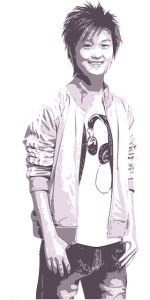Main Body
The Big Five: Personality
Learning Goals
In this chapter, you will learn to:
- Use pre-reading strategies
- Set a purpose for reading
- Build your vocabulary
- Understand the main ideas and details of a text
- Draw conclusions
- Spell words with the suffix -ous
- Use commas with appositives
- Edit for shifting verb tense
- Write a descriptive paragraph

Get Ready to Read
Think about the questions below or discuss them with a partner.
- How do others see you?
- How do you see yourself?
- What do you like about your personality?
- If you could change one thing about your personality, what would it be?
Reading Strategy
Readers use texts for many different purposes. We read stories for enjoyment. We read the news to find out what is happening in the world. We read cookbooks to follow a recipe. We read instructions to find out how to put together or use something new. Before you read, think about your purpose for reading. It is easier to use a text when we know why we are using it. The next text you will read is called The Big Five: Personality. Below are some examples of purposes for reading this text:
- To find out more about your personality. As you read, you might ask yourself, “What words in this text describe my personality?”
- To learn what “the big five” are. As you read, you might circle the words that make up “the big five.”
- To find the vocabulary words and figure out what they mean.
- To enjoy yourself.
You may wish to re-read a text a few times, with a different purpose each time. This is a way to get as much information, enjoyment, and reading practice from a text as possible.
Try setting a purpose for reading The Big Five: Personality.
Vocabulary
Find these words in the text. Use the context to choose the best meaning.
| upbringing | bossy | fussy | curious | unpredictable |
| practical | closed-minded | stubborn | genes |
1. Someone who is _____________________ is able to deal with daily life in a way that makes sense.
2. Someone who is _____________________ is hard to please.
3. Someone who is _____________________ is not behaving as expected.
4. Someone who is _____________________ is not willing to listen to different ideas or opinions.
5. Someone who is _____________________ refuses to change their ideas or stop doing something.
6. Someone who is _____________________ tends to tell others what to do.
7. A _____________________ is the part of a cell that controls how a living thing looks and grows.
8. _____________________ refers to the way a child is raised.
9. Someone who is _____________________ wants to know about things.
Check Your Understanding
Answer these questions in complete sentences.
1. What are the five factors researchers use to describe personality.
2. What is the advantage of being an introvert?
3. What is the advantage of being less agreeable?
4. What is the disadvantage of being open?
5. What is the disadvantage of being conscientious?
6. What is the advantage of being less sensitive?

Antonyms are words that have an opposite meaning. Find an antonym in the text for the words below.
7. open
8. extrovert
9. stubborn
Read the descriptions of each person below. Match the personality trait to each person.
| open | conscientious | agreeable | introverted | sensitive |
10. Lee always does her homework and is never late for school. She writes everything in black pen because she thinks blue looks too messy.
11. Tim loves his partner so much he could burst. He wrote a poem to express his feelings, but was so worried his partner would hate it that he tore it up.
12. On most Friday nights, you’ll find Juan in his pajamas reading a book. If the phone rings, he looks to see who’s calling. He won’t answer it unless it’s his best friend.
13. Sam likes to skateboard, fly kites, play the keyboard, and go bowling. He might join a soccer team next summer.
14. Frieda always greets the people she sees on the street. Once a week, she mows her neighbour’s lawn. Today, she lent her favourite book to a guy she met on the bus. She’s pretty sure she’ll get it back.
Spelling
Study these words ending in –ous. The suffix –ous means “full of.” Arrange a date to be tested on your ability to spell these words.
|
various serious previous obvious curious |
famous nervous generous dangerous enormous |
One way to figure out how to spell a word is to sound out each syllable. Break up these words into their syllables.
1. various = ______ ______ ______
2. serious = ______ ______ ______
3. previous = ______ ______ ______
4. obvious = ______ ______ ______
5. curious = ______ ______ ______
6. famous = fa ______
7. nervous = ______ ______
8. generous = ______ er ______
9. dangerous = ______ ger ______
10. enormous = ______ nor ______
Commas with Appositives
Grammar Rule
Extra information in a sentence is called an appositive. If you delete the appositive, you will still have a complete sentence.
Use a comma before and after the appositive.
| Sentence | Sentence with extra information |
| Dave is easy-going. | Dave, my teacher, is easy-going. |
| My dog loves adventure. | My dog, a Jack Russell named Huck, loves adventure. |
| This book is interesting. | This book, The Giver, is interesting. |
If the appositive comes at the end of the sentence, only use a comma before the appositive.
| Sentence | Sentence with extra information |
| This is my friend. | This is my friend, Raven. |
| Canada comes from the Mohawk word “kanata.” | Canada comes from the Mohawk word “kanata,” which means “village.” |
| She goes to Vancouver Community College. | She goes to Vancouver Community College, the biggest and oldest college in British Columbia. |
Fill in the commas in the sentences below.
1. Many animals such as starfish and jellyfish survive without a brain.
2. Aristotle the world’s first great scientist thought that the brain’s only job was to keep the body from getting too hot.
3. A doctor in the 1790s Franz Joseph Gall believed he could figure out a person’s personality by studying the bumps on their head.
4. The corpus callosum which allows both sides of the brain to talk to each other is bigger in most musicians.
5. According to a popular personality test which is known as the Myers-Briggs Type Indicator there are 16 personality types.
6. The Rubik’s Cube which tests a person’s ability to visualize is the world’s best-selling toy.
7. Sign language which is based on the use of sight uses the same parts of the brain as language that is based on the use of sound.

Shifting Verb Tense
You have learned about some of the common errors to avoid in your paragraph writing: fragments, run-ons, and subject-verb problems. The final error explored in this book is the shifting verb tense.
When you write a paragraph, choose a verb tense and stick to it unless you have a good reason not to.
Look at the paragraph below. Does it begin in past, present, or future tense? What verb tense does it shift to for no reason? Rewrite the paragraph in one consistent verb tense.
There are five styles for dealing with conflict: turtle, teddy bear, shark, owl, and fox. The turtle hides his head in his shell and hopes the trouble will go away. The teddy bear will try to make everyone feel better, even if it means putting others’ needs first. The shark just wants to win the argument and doesn’t care about how others feel. The fox will look for compromise, where one side or both sides give up part of what they want. The owl will look for win-win solutions where both sides get what they want. Which one of these five approaches to dealing with conflict best describes you?

Writing
Writing Task
There are many personality tests that help people figure out what job would be a good match for them. Choose a job, such as doctor, parent, social worker, or server. Describe the kind of personality someone needs to succeed in this job.
Follow the TOWER method:
- Think about what jobs you might like to write about. Choose one. Brainstorm some of the qualities a person needs to be successful in this job. Try to use interesting vocabulary words.
- Organize your ideas. What details will you include? What order will you put them in?
- Write your first draft. Include a topic sentence, details, linking words, and a concluding sentence.
- Edit your paragraph, with the help of your instructor and The Big Five: Personality description checklist.
- Rewrite a final copy of your paragraph. You may wish to type it on a computer. Finally, hand it in to your instructor.
Ask your instructor for a copy of the checklist, or print one from the link above. For a printable version, see Appendix 2.
Answer Key
| Vocabulary | |
| QUESTION | ANSWER |
| 1 | practical |
| 2 | fussy |
| 3 | unpredictable |
| 4 | closed-minded |
| 5 | stubborn |
| 6 | bossy |
| 7 | gene |
| 8 | upbringing |
| 9 | curious |
| Check Your Understanding | |
| QUESTION | ANSWER |
| 1 | The five factors that researchers use to describe personality are how open, conscientious, extroverted, agreeable, and sensitive a person is. |
| 2 | The advantage of being an introvert is that introverts tend to be good at listening and reflecting. |
| 3 | The advantage of being less agreeable is that this kind of person can challenge others to do what is right. |
| 4 | The disadvantage of being open is that this kind of person may be seen as unpredictable or unfocussed. |
| 5 | The disadvantage of being conscientious is that this kind of person may be seen as stubborn or fussy. |
| 6 | The advantage of being less sensitive is that this kind of person is more likely to feel calm, relaxed, and confident. |
| 7 | closed |
| 8 | introvert |
| 9 | easy-going |
| 10 | Lee is conscientious. |
| 11 | Tim is sensitive. |
| 12 | Juan is introverted. |
| 13 | Sam is open. |
| 14 | Frieda is agreeable. |
| Spelling | |
| QUESTION | ANSWER |
| 1 | var – i – ous |
| 2 | ser – i – ous |
| 3 | pre – vi – ous |
| 4 | ob – vi – ous |
| 5 | cur – i – ous |
| 6 | fa – mous |
| 7 | ner – vous |
| 8 | gen – er – ous |
| 9 | dan – ger – ous |
| 10 | e – nor – mous |
| Commas with Appositives | |
| QUESTION | ANSWER |
| 1 | Many animals, such as starfish and jellyfish, survive without a brain. |
| 2 | Aristotle, the world’s first great scientist, thought that the brain’s only job was to keep the body from getting too hot. |
| 3 | A doctor in the 1790s, Franz Joseph Gall, believed he could figure out a person’s personality by studying the bumps on their head. |
| 4 | The corpus callosum, which allows both sides of the brain to talk to each other, is bigger in most musicians. |
| 5 | According to a popular personality test, which is known as the Myers-Briggs Type Indicator, there are 16 personality types. |
| 6 | The Rubik’s Cube, which tests a person’s ability to visualize, is the world’s best-selling toy. |
| 7 | Sign language, which is based on the use of sight, uses the same parts of the brain as language that is based on the use of sound. |
| Shifting Verb Tense | |
| This paragraph begins in the present tense and shifts to the future tense for no good reason. Here is a corrected version: | |
| There are five styles for dealing with conflict: turtle, teddy bear, shark, owl, and fox. The turtle hides his head in his shell and hopes the trouble will go away. The teddy bear tries to make everyone feel better, even if it means putting others’ needs first. The shark just wants to win the argument and doesn’t care about how others feel. The fox looks for compromise, where one side or both sides give up part of what they want. The owl looks for win-win solutions where both sides get what they want. Which one of these five approaches to dealing with conflict best describes you? | |
Attributions
Personality
Image by RyanMcGuire is in the public domain.
Teenager
Image by OpenClipartVectors is in the public domain.
Rubik’s cube
Image by OpenClipartVectors is in the public domain.
Turtle
Image by wjgomes is in the public domain.

